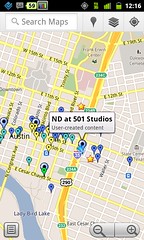(This is gonna be a long one, so if you’re sticking around, enjoy some tracks from some acts I caught; the Civil War/Revival Folk was big this year)
I was meaning to post something up sooner, but alas, crazy work deadlines and SxSARS have conspired against me this week. Miraculously, I managed to stave off sickness for all 10 days in Austin, but I ended up picking something up (I think) on my plane flight home (I’m looking at you coughy mccougherson in the next seat over). In any case, some less than organized thoughts while they’re somewhat fresh.
First, on SXSWi (Interactive), I think Gruber nailed it pretty spot on:
Used to be that SXSW[i] was an interesting conference and a great weekend experience. Now it’s a terrible conference and a good-but-crowded weekend experience.
As someone that actually lays down my own cash for SXSW, I was pretty offended by how horrible the conference setup was this year. I think Matt might have had more success with my Lanyrd than I did. This was by far my worst panel year ever (this was SXSWi #12 for me, and the past few years were fine, thank you very much), not because of the panel quality, which has continued to improve, but because the logistics have gotten precipitously worse. The panel/room scheduling was a mess (with some of the most popular sessions in the smallest rooms), and the half-assed shuttles (unmarked, not on any schedule, never there before or after sessions, taking you on a loop around town; some unlucky people apparently got shaken down by similar unmarked pay shuttles) and across-town campuses was an unmitigated disaster (the word clusterfuck is the term that comes to mind). I met some friends who had much better experiences – they did the sensible thing and just didn’t bother attending anything not in ACC/Hilton. Lesson learned.
Anyway, if I went to SXSW for the panels still, I’d be kicking and screaming for a refund. I’ll let others argue about the ethics of taking money from attendees that the conference clearly doesn’t have the capacity to support. My simple suggestions for fixing things (as there were sessions I would have love to have caught):
- If you’re going to be selling Interactive Badges, where people are paying for panels, they need to be within the ACC block. Move Film panels if you need to, find some creative locations nearby (lots of boarded up stuff), or (god forbid) stop fucking selling badges if you’re over capacity, but having to choose between a 1hr roundtrip or a $12 cab ride to see a panel at the Hyatt is pretty much the definition of bullshit. (even worse were those that made a hike to find the panel they were going to was full or canceled)
- Millions of dollars in badge receipts and you’re telling me you can’t UStream all the sessions and make them available in simulcast and archive form for attendees? This seems like a completely reasonable and rather simple solution. If a speaker doesn’t agree, fine, mark it on the schedule (or tell them tough noogies), but this seems like a no-brainer for most of these.
- Stop being fucking babies and open up your schedule API to Lanyrd, SCHED, etc. These tools are way better than anything your team has done, and if there was less time wasted writing their own scrapers to your (not well formed) data, they would be more accurate and could coordinate better – especially for tracking attendance, demand, etc. This year, SCHED provided Foursquare with its SXSW event data. Why? Because there was an API and they had their shit together.
- In an interesting regression, conference staff seems less willing to swap rooms, even when there’s an obvious mismatch (and an obvious swap candidate right next door) a half hour before the session…
OK, that’s all the indignation I can really muster up. Etsy threw a better conf down the block. That’s pretty sad yo.
Anyway, I’ve never been a fan of the “SXSW is too big” meme… but, I found that this year, much more than the past couple years even, that I had some issues for the first couple days getting into the SXSWi groove. Primarily, SXSWi is a time for me to meet up with “200 of my closest friends” – the people of my tribe that I might only see once every year or two. In the past, it was much easier to depend on serendipity (and over the past couple years, some dependable end-of-night hangouts), but I found this to be a bit harder this year. Part of it I think had to do with the aforementioned shitshow with panels – I didn’t realize how much of my dinner plans depended on the group of 5 people that I’d run into after the last panel session (of course, this was also my first year over a decade without a Break Bread w/for Brad to kick things off…).
All that being said, I ended up having a pretty good time, especially once I realized I’d have to work a bit harder at social planning, and rallied.
- The Old Timers Ball was a great idea. During SXSWi, I have two rules of thumb that have served me well: 1) no waiting in line and 2) I don’t mind paying for my own drinks. (Especially during Interactive, many people seem to break #1 for #2).
- I don’t believe I had a sit-down meal until my 3rd day in Austin. I did however have the pleasure of sharing and introducing fried oreos to more than a few friends. The East Side Drive-In was one of the best surprises this year. If you didn’t make it out there, you have something for your TODO list now.
- Speaking of pleasant surprises, two words: CNN Grill. So good that I’m not even going to make the obvious snarky observations in relation to the quality of their reporting.
- The following hashtags (on 4SQ! barely used Twitter @ SXSW) were useful: #noshitshow, #noline, #oldtimers
- I mentioned this in a tweet, but despite the hype (and my own personal expectations) that GroupMe or Beluga would be useful, it turned out that 4SQ was much more useful for coordination. I ended up in 5 SXSW GroupMe groups, but it turns out that while GroupMe might be well-suited for small groups of strong-ties, it’s absolutely useless as a serendipity enabler. 4SQ wasn’t perfect, but it was pretty good (more in-depth thoughts below).
- Cell networks stood up much better this time around, both during Interactive and Music it seemed like. I was using Sprint, which dropped down to 1x much too often, but also had 3-4Mbps 4G available (at the cost of destroying battery life).
- Interestingly, because of the huge new venues that had opened up (the Power Plant, the new ACL, the Pepsi Max Warehouse), I ended up swinging into some mega-parties during interactive that were relatively uncrowded. The night we agglomerated a gaggle of Brits into a big nerd pack, we rolled into the RedLaser Chromeo sans-line (there were maybe 500 people at a probably 2000 capacity venue?). Rolling in at the end of the 4SQ Big Boi concert, and into the Microsoft Yeasayer party were similarly pleasant experiences. Maybe all those hundreds-thousands of people standing in line at Mohawks and Stubbs is a good thing? It seems like there was definitely a big gap in terms of good real-time crowd reporting…
Which is as good a segue as any to talk about 4SQ. First of all: holy crap are these guys hitting it out of the park. Between the great 3.0 features and the crazy biz dev (AMEX, etc), it’s just great seeing 4SQ really starting to fulfill some of that LBS potential. (it’s only been a decade or so in the making, right?) Comments in particular, super useful this year. It’s with that in mind (and the fact that I actually lived up to my Super User status this year) that some constructive criticism is offered:
- Two 4SQ apps, 4squareand7yearsago and flicksquare were especially nice, especially since then former had an “early adopter” edition during SXSWi that sent you a history of your checkins from 2 years ago. A nice reminder of how your checkins could be personally valuable
- While I had mentioned that 4SQ was more useful than the group chats for coordination, it was still not ideal. A few thoughts in that regard:
- While the checkin is useful, two verbs that I was most missing were “heading to” and “leaving.” Being able to signal intent would be killer, especially if you were trying to catch up with someone or vice versa. This could be a picoformat in shouts (like “>” or “/l” with @names), but would be nice if it were parsed in the system
- Along those lines, it seems like something like Ditto where you could propose a meetup/location would be super useful as a 4SQ feature rather than a separate app, especially if it integrated with some realtime status
- I didn’t end up rolling this out due to some complications, but one of the things that I worked on for the SCHED map was a way of reporting realtime status (lines, crowds, lateness) to a venue. There’s no reason this couldn’t be implemented in 4SQ
- The map view was pretty useless with a lot of friends checked in. More interesting views would be heatmaps that showed say a time+density based visualization (venue trends) as well as say, relative crowdedness to people you knew. The ideal venue at SXSW is actually the least crowded venue with the highest percentage of people you know checked in!
- That being said, while 4SQ was OK during Interactive, for whatever reason, it worked way better during Music. Ended up catching a bunch of bands and having a bunch people roll in to meet up based on checkins/shouts. Also super great way to ask friends what the line/crowd/lateness status was.
- A heavy concentration of 4SQ users meant that you rarely had to search to find your checkin location. Which is good, because SRPs continued to be astoundingly bad. Searching for the Hilton or ACC or Convention Center would rarely turn it up in the first several screens (which would seem impossible if even the most basic popularity/activity ranking was being used). Also, this may be Android specific, or maybe based on service timeouts, but my Favorites rarely showed up at the top. Lastly, as a SU I saw things that I constantly would want to merge, but just couldn’t (unless I’m missing something in the Mobile UI)
- Related to “riding” on checkins, I hope (but doubt) that 4SQ are tracking this? I (and I suspect most people) tend to pick friends checked in when hopping on their checkin locations – there’s some crazy future data-mining+awesomeness generation potential there (even beyond the current co-presence data being used).
- There’s no way to unsubscribe or block a user from the app! Or the mobile site?! Or, watching kathrynyu unsuccessfully try, even via iPad. WTF?! That’s bad!
- Sadly, iOS Notifications has actually caused a big regression with 4SQ this – while I didn’t notice it on my Android phone because notifications queue into the notification bar, using my iPad even for a few minutes made me realize how it sucked big time for iOS users. Basically, like the bad old days w/ Dodgeball SMS’s (the social app that punished you as your friends used it more as I liked to put it), except iOS Notifications are even worse, popping up in a constant stream in the middle of your screen. The only solution I can think of really of (besides waiting for iOS 5?) is for there to be an easier way to turn Pings Off for users or to institute internal digesting/summarizing/rate limiting against iOS notifications.
- Annoying niggle only notice through mega-usage: when you successfully checkin on Android, it doesn’t update your location in your listing. This is especially annoying when you’re on a slow network since it has to poll to update. In general, having a “last updated” status would be useful. Overall 4SQ still has a ways to go to be more useful when you’re offline, even updating the time rendering at least would be a good first step.
SXSW has been “on notice” for me for the past few years (I had originally decided that 10 years running was really longer than I needed to do anything, but it’s just been too fun to stop), but this year, at the end of SXSWi, when I realized I still had 5 more days, I was pretty sure it’d be time to take a break (surely I have better things to do with $4K and 10 days). However, Music was actually a total 180: completely re-energizing in all the ways that Interactive was enervating. I had a great time.
Instead of taking video, I ended up using a combination of 4SQ and a new app called Whoa to track the bands I caught (66 rated, yeah!). This year, SCHED tracked just under 7300 events (almost 50% of the parties and music events were unofficial), with over 4500 users (tracking on average over 60 events each)… As I side-note, while I know SXSW has a sometimes rocky relationship with “unofficial” events, and heck, even with SCHED, but, it’s a big part of the reason they’ll be getting my Platinum badge money if I’m back next year, not to mention why its worthwhile for most of the bands that come. It’s the fact that bands will play multiple shows (building buzz and letting fans catch them in an otherwise impossibly packed schedule) that really distinguishes SXSW from everything else.
Interactive peeps, if I catch you in Austin next year, sadly, it’ll probably be in-spite of SXSW rather than because of it.





